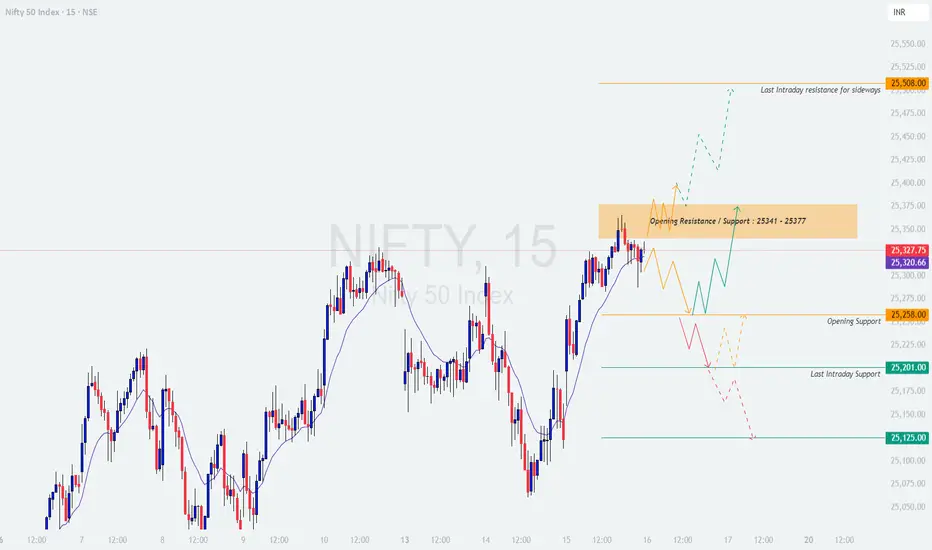NIFTY 50 – Professional Trading Plan for 16-Oct-2025 (educational)
Market context and key levels
Reference map from 15‑Oct close: price is hovering around 25,320 with an opening resistance/support band at 25,341–25,377; immediate supports at 25,258 (opening support) and 25,201 (last intraday support), with a deeper line in the sand near 25,125. Trend bias is constructive above 25,258 and momentum unlocks only on acceptance above 25,377; sustained loss of 25,201–25,125 flips control to bears. 🚦
GAP UP OPEN (≥ +100 pts)
Educational logic: A strong positive gap often traps shorts from the prior day. The edge is to wait for “acceptance” (time + volume) above resistance rather than chasing a spike.
Market context and key levels
Reference map from 15‑Oct close: price is hovering around 25,320 with an opening resistance/support band at 25,341–25,377; immediate supports at 25,258 (opening support) and 25,201 (last intraday support), with a deeper line in the sand near 25,125. Trend bias is constructive above 25,258 and momentum unlocks only on acceptance above 25,377; sustained loss of 25,201–25,125 flips control to bears. 🚦
GAP UP OPEN (≥ +100 pts)
Educational logic: A strong positive gap often traps shorts from the prior day. The edge is to wait for “acceptance” (time + volume) above resistance rather than chasing a spike.
If open is inside or just above 25,341–25,377 and the first 5–15 minutes hold above VWAP, consider a momentum long toward 25,420–25,450; partial profit inside the band, then trail for 25,508 (prior sideways resistance marker). Stop below the retest low of the zone.
If open is directly near 25,480–25,520, avoid chasing into resistance. Prefer a pullback to 25,377/25,360. Go long only on a higher low plus reclaim of 25,400 with a tight stop under the pullback low; targets 25,480 → 25,508.
Failure short: Rejection wicks from 25,400–25,480 followed by a 15‑min close back below 25,360. Take a tactical short to 25,341 → 25,300–25,258. Exit if price reclaims 25,377 with strength.
[/list=1]
FLAT OPEN (±0–50 pts)
Educational logic: Neutral open favors range trading between nearby pivots until the market shows acceptance beyond the range. ⚖️
Range buy: Look for reversal candles near 25,280–25,258 with risk below the session swing; targets 25,341–25,360, then 25,377 if acceptance builds.
Breakout buy: A 15‑min close and retest hold above 25,377 opens 25,400–25,450; scale out on the way to 25,508 if momentum broadens.
Breakdown short: Acceptance below 25,258 on retest aims 25,220–25,201; if sellers keep control, extend to 25,150–25,125. Manage risk by moving stops above the last lower high.
[/list=1]
GAP DOWN OPEN (≤ −100 pts)
Educational logic: Negative gaps near support can lead to “gap‑and‑go” trend days or sharp reversals if responsive buyers defend key zones. 📉
Gap‑and‑go short: Open near 25,210–25,201 and failure to reclaim 25,201 on retest → short to 25,150, then 25,125. Take partials at each target; trail using 5–15 min lower highs.
Reversal long: Strong rejection from 25,125 (long lower wicks/engulfing) → long back to 25,201 then 25,258; shift stop to breakeven once 25,201 is accepted.
Bias flip: If price re-enters above 25,258 and sustains, abandon shorts and prepare for rotation to 25,341–25,377. Avoid fighting a reclaim day—trade with the acceptance, not the open.
[/list=1]
Execution checklist
Predefine scenario, entry trigger (acceptance/retest), invalidation (where the idea is wrong), and first target.
Treat 25,258, 25,341–25,377, and 25,508 as decision areas. Trade the reaction to these levels rather than the level itself.
Use structure-based stops: beyond the last swing or the far side of the zone. Scale out at the next pivot and trail to protect gains.
Options risk management tips- Define risk: Prefer debit spreads over naked options at key zones (bull call above 25,377; bear put below 25,258) to cap tail risk on volatile opens.
Size by volatility: Wider expected ranges require smaller position size; don’t oversize because premiums look “cheap.”
Liquidity first: Stick to near‑ATM, current‑week options with tight spreads; avoid far OTM contracts that decay rapidly if the market ranges.
Enter on confirmation: Use a 15‑min acceptance or a clean retest hold to avoid false breakouts; avoid entries during the first 1–3 minutes unless trading a planned opening drive.
Manage winners: Take partials at the first pivot; if IV expands in your favor, consider converting naked calls/puts into verticals to lock risk while keeping upside.
Event awareness: Watch for midday global cues; if structure flips (e.g., reclaim of 25,258 after a breakdown), exit losers decisively instead of hedging passively.
[/list=1]
Summary
Primary range: 25,258 support to 25,377 resistance. Upside continuation requires acceptance above 25,377 to target 25,400–25,450 and potentially 25,508. Downside momentum strengthens on acceptance below 25,258 toward 25,201 and 25,125. Trade level‑to‑level, let acceptance guide direction, and prioritize defined risk. 😊
Conclusion
Prepare three plays: continuation long above 25,377, responsive range trades around 25,258/25,341, and momentum shorts below 25,258 with extensions to 25,201–25,125. Execute with clear invalidations, scale responsibly, and adapt quickly if key pivots are reclaimed. 📊
Disclaimer: This is an educational plan, not investment advice or a trade recommendation; I am not a SEBI registered analyst.
- Define risk: Prefer debit spreads over naked options at key zones (bull call above 25,377; bear put below 25,258) to cap tail risk on volatile opens.
إخلاء المسؤولية
The information and publications are not meant to be, and do not constitute, financial, investment, trading, or other types of advice or recommendations supplied or endorsed by TradingView. Read more in the Terms of Use.
إخلاء المسؤولية
The information and publications are not meant to be, and do not constitute, financial, investment, trading, or other types of advice or recommendations supplied or endorsed by TradingView. Read more in the Terms of Use.
